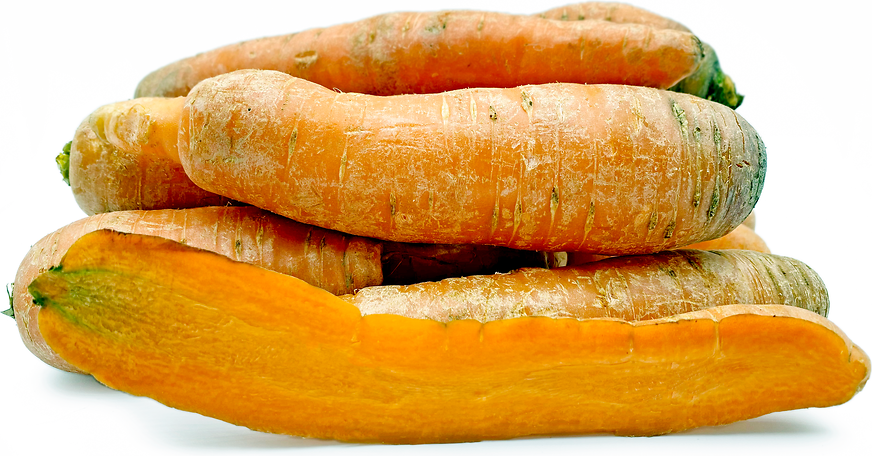


Bolero Carrots
Estimated Inventory, lb : 0
Description/Taste
Bolero carrots are thick roots, averaging 17 to 20 centimeters in length, and have a cylindrical shape with blunt, curved ends. The skin is firm, semi-smooth, and orange with dark green patches on the root’s shoulders, and the attached, frilly green tops are noticeably tall extending over twenty-five centimeters in length. Underneath the skin, the flesh is dense, fine-grained, crisp, and juicy, maintaining a solid orange hue to the core. Bolero carrots are crunchy with a snap-like quality and have a mild, sweet, and earthy flavor.
Seasons/Availability
Bolero carrots are available year-round, with a peak season in the fall through winter.
Current Facts
Bolero carrots, botanically classified as Daucus carota, are a hybrid variety that belongs to the Apiaceae family. Considered to be a nantes type carrot, which is a grouping that includes over forty different varieties, Bolero carrots are highly favored in commercial markets and home gardening for their easy-to-grow nature. The thick, round, and blunt roots have extended storage capabilities, thrive in many different climates and soil types, and are commonly cultivated as a late-season crop. They are also one of the highest yielding cultivars, and their large tops can be mechanically harvested for faster production rates. Outside of commercial industries, Bolero carrots are favored by consumers for their sweet flavor and versatility in both fresh and cooked applications.
Nutritional Value
Bolero carrots are an excellent source of vitamin A, which can help reduce vision loss and improve skin complexion. The roots are also a good source of vitamin C, which is an antioxidant that can boost the immune system, and contain some fiber, vitamin K, potassium, folate, magnesium, and calcium.
Applications
Bolero carrots are best suited for both raw and cooked applications such as sautéing, blanching, roasting, and steaming. The roots are commonly consumed fresh, out-of-hand to showcase their sweet flavor and crunchy texture, or they can be chopped and tossed into green salads, pressed into juice, sliced and layered on appetizer plates, and grated and mixed into coleslaws. The bright orange roots can also be carved into different shapes as an edible garnish, and the leafy green tops can be used as a finishing herb. In addition to fresh applications, Bolero carrots can be minced into dumplings, cooked into soups and stews, lightly stir-fried, layered under roasts, or grated and baked into cakes, muffins, and bread. Bolero carrots pair well with spices such as paprika, curry powder, cinnamon, nutmeg, and cumin, fresh herbs such as thyme, rosemary, sage, and parsley, lemon juice, celery, cabbage, kale, onions, garlic, potatoes, raisins, and nuts such as pistachios, walnuts, and pine nuts. The roots will keep up to one month when stored in a plastic bag in the crisper drawer of the refrigerator. They can also be blanched and frozen without compromising the flavor or texture.
Ethnic/Cultural Info
In Australia, nantes carrot varieties such as the Bolero carrot are commonly grown in home gardens and through commercial farms in the coastal regions. The thick, round carrots were selected and introduced in the 1990s for their adaptable and easy-to-grow nature, and the roots have become a favored variety of consumers for fresh eating. Carrots are one of the most commonly cultivated crops in Australia for human consumption, but the orange roots were recently used to sustain a different population. In early 2020, Australia suffered many massive bush fires that destroyed the majority of the endangered Brush-Tailed Rock Wallaby’s natural habitat in New South Wales. In order to preserve the population, over four thousand pounds of carrots and sweet potatoes were air-dropped from a helicopter into the Wolgan and Capertee valleys to temporarily feed the species. Labeled as Operation Rock Wallaby, wildlife rescuers were able to provide a quick source of food for the species through the fresh carrots until the habitat could be restored.
Geography/History
The origin of Bolero carrots is mostly unknown, but the cultivar is a type of nantes carrot, which is a grouping of carrots that were developed from a variety in the late 1850s by famous French botanist Henri Vilmorin. Nantes carrots were then introduced to the United States through seed catalogs in 1870 and were also spread to many regions throughout the world, where they quickly became a favored carrot for commercial cultivation. Today Bolero carrots can be found through local growers at farmer's markets, in select specialty grocers, and are also sold through online seed catalogs for home garden use in Europe, Asia, Australia, Canada, and the United States.












